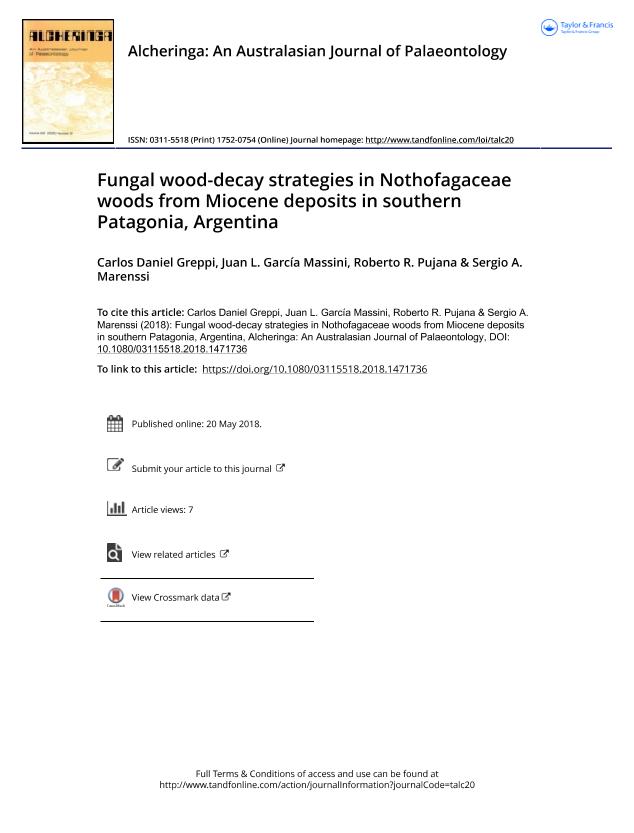Artículo
Fungal wood-decay strategies in Nothofagaceae woods from Miocene deposits in southern Patagonia, Argentina
Greppi, Carlos Daniel ; García Massini, Juan Leandro
; García Massini, Juan Leandro ; Pujana, Roberto Roman
; Pujana, Roberto Roman ; Marenssi, Sergio Alfredo
; Marenssi, Sergio Alfredo
 ; García Massini, Juan Leandro
; García Massini, Juan Leandro ; Pujana, Roberto Roman
; Pujana, Roberto Roman ; Marenssi, Sergio Alfredo
; Marenssi, Sergio Alfredo
Fecha de publicación:
07/2018
Editorial:
Taylor & Francis Ltd
Revista:
Alcheringa
ISSN:
0311-5518
Idioma:
Inglés
Tipo de recurso:
Artículo publicado
Clasificación temática:
Resumen
Carlos Daniel Greppi, Juan L. García Massini, Roberto R. Pujana and Sergio A. Marenssi, May 2018. Fungal wood-decay strategies in Nothofagaceae woods from Miocene deposits in southern Patagonia, Argentina. Alcheringa xxx, xxx -xxx. Decayed woods from the Miocene, Rio Leona Formation, Santa Cruz, Argentina having simultaneous decay patterns consistent with soft- and white rot characteristics are described. Samples were previously identified as Nothofagoxylon scalariforme. At low magnification, the permineralized woods appear mottled, with discoloured, degraded areas, scattered in apparently robust tissue, consistent with white-rot decay. At greater magnification, the woods reveal several micromorphological features, including differential decay of cellulose-rich cellular components that match soft-rot decay by extant ascomycetes and some basidiomycetes. In addition, decayed woods either appear differentially delignified or show simultaneous decay of all cellular components (lignin- and cellulose-rich), which are by-products of white-rot fungal decay. Additional anatomical characteristics of the decayed woods are consistent with a host response to the fungal attack. Co-occurrence of these two decay patterns suggests soft-rot decay and white-rot fungal decay. In addition, co-occurrence of all the decay features observed also suggests facultative soft rot by white-rot fungi, such as in some extant species that switch between these two types of decay strategies as a means to circumvent plant defences. These data indicate that fungi with soft-rot capacity for wood decay can be traced back to the early Miocene (ca 19 Ma). In addition, this report adds to the distribution and diversity of fungi in the geological record and underscores the ecological importance of wood as a preferred substrate for the association and interactions between fungi with different saprotrophic abilities, which have been fundamental for nutrient recycling in terrestrial ecosystems during the Cenozoic.
Archivos asociados
Licencia
Identificadores
Colecciones
Articulos(CRILAR)
Articulos de CENTRO REGIONAL DE INV. CIENTIFICAS Y TRANSFERENCIA TECNOLOGICA DE ANILLACO
Articulos de CENTRO REGIONAL DE INV. CIENTIFICAS Y TRANSFERENCIA TECNOLOGICA DE ANILLACO
Citación
Greppi, Carlos Daniel; García Massini, Juan Leandro; Pujana, Roberto Roman; Marenssi, Sergio Alfredo; Fungal wood-decay strategies in Nothofagaceae woods from Miocene deposits in southern Patagonia, Argentina; Taylor & Francis Ltd; Alcheringa; 42; 3; 7-2018; 427-440
Compartir
Altmétricas



